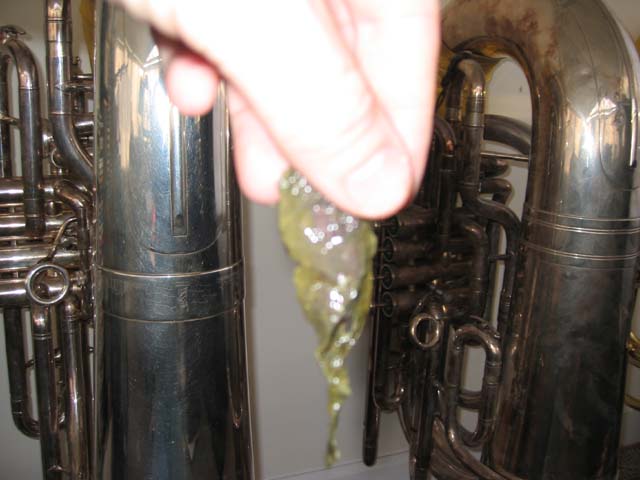Mostly, what we call "stuffy" is a comparative (to other notes) loss of resonance. A leak can often make a note feel "stuffy".
Similarly, your instrument's valves may be worn and leaky. If the C feels stuffy, how about the low F below it? Does the B natural (123) also feel stuffy? If so, I'd put my money on the valves, particularly given the age of your instrument.
As an experiment, try some very heavy oil (like 50 weight motor oil) in your valves. Does the C feel less stuffy? If so, you've probably got your answer.
What may make a tuba "stuffy"
- Chuck(G)
- 6 valves

- Posts: 5679
- Joined: Fri Mar 19, 2004 12:48 am
- Location: Not out of the woods yet.
- Contact:
- Dean E
- 5 valves

- Posts: 1019
- Joined: Fri Mar 19, 2004 10:36 am
- Location: Northern Virginia, USA
- Contact:
Re: What may make a tuba "stuffy"
1. Possibly dented and caved-in slides for the valves.Nate_pls wrote:I play a Pan American sousaphone in a community band. The C below the staff is very "stuffy". I am curious what conditions will make this happen?
2. Green stuff growing in the slides and valves.
3. Misalinged valves.
4. Leaky valves and leaks anywhere else. Sometimes valves are scavenged from one horn to another without regard to how well they fit.
Dean E
[S]tudy politics and war, that our sons may have liberty to study mathematics and philosophy. Our sons ought to study mathematics and philosophy . . . in order to give their children a right to study painting, poetry [and] music. . . . John Adams (1780)
[S]tudy politics and war, that our sons may have liberty to study mathematics and philosophy. Our sons ought to study mathematics and philosophy . . . in order to give their children a right to study painting, poetry [and] music. . . . John Adams (1780)
- Art Hovey
- pro musician

- Posts: 1508
- Joined: Sun May 02, 2004 12:28 am
- Location: Connecticut
First: Most BBb sousaphones have a couple of tight loops in the third-valve tubing. Older King and Conn front-action upright tubas have similar arrangements. Newer ones have single-loop third valve tubing which is more prone to damage but noticeably freer-blowing if undamaged.
Second: I have seen repair jobs by unscrupulous people that look wonderful but are acoustically a crime; They put a crude and ill-fitting patch on the inside of a damaged piece of curved valve tubing, and then polish up the outside so that it looks beautiful.
Third: Another factor is a bore size that is just too small. It seems as if most piston tubas are designed by trumpet players who just don't understand what a difference a larger bore can make when you try to play low C and B, and F and E. No third or fourth-valve tubing on a BBb tuba should ever be less than .750", and when I get to be dictator that will become the law!
Second: I have seen repair jobs by unscrupulous people that look wonderful but are acoustically a crime; They put a crude and ill-fitting patch on the inside of a damaged piece of curved valve tubing, and then polish up the outside so that it looks beautiful.
Third: Another factor is a bore size that is just too small. It seems as if most piston tubas are designed by trumpet players who just don't understand what a difference a larger bore can make when you try to play low C and B, and F and E. No third or fourth-valve tubing on a BBb tuba should ever be less than .750", and when I get to be dictator that will become the law!
- Lew
- 5 valves

- Posts: 1700
- Joined: Fri Mar 19, 2004 4:57 pm
- Location: Annville, PA
I think that some designs just have inherent problems. I have a Conn 28K sousaphone (4 valve Eb) on which the low Bb just doesn't want to speak well. It doesn't matter whether I use the 4th valve or 1&3, it takes some finesse to play that note. Everything above it is fine, but any of the combinations below, A, Ab, G, Gb, and F, have the same problem. The low Eb is fine though. It has been described as being the same type of issue that seems to be common with the low C on an F tuba.
This horn has been worked on by two of the top technicians in the country, Robb Stewart and Lee Stofer. The valves have been redone and it has been checked for leaks, blockage, or alignment issues. I think that it may just be the horn.
This horn has been worked on by two of the top technicians in the country, Robb Stewart and Lee Stofer. The valves have been redone and it has been checked for leaks, blockage, or alignment issues. I think that it may just be the horn.
- DBCooper
- bugler

- Posts: 95
- Joined: Fri Apr 28, 2006 4:36 pm
- Location: Still out there
<img src="http://www.ibowtie.com/brassforum/image ... oubles.jpg" width="200">
Carpe filum (seize the thread!)
-
poomshanka
- 4 valves

- Posts: 682
- Joined: Thu Mar 18, 2004 10:54 pm
- Location: Parts Unknown
-
tubatooter1940
- 6 valves

- Posts: 2530
- Joined: Mon Mar 22, 2004 11:09 pm
- Location: alabama gulf coast
- Chuck(G)
- 6 valves

- Posts: 5679
- Joined: Fri Mar 19, 2004 12:48 am
- Location: Not out of the woods yet.
- Contact:

